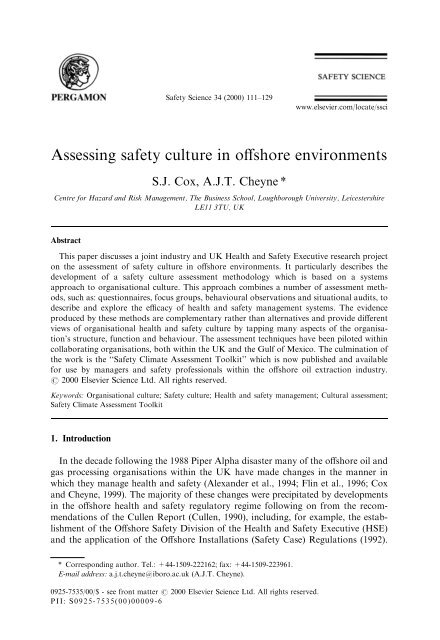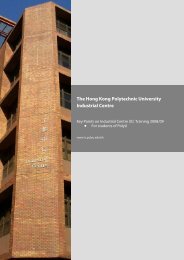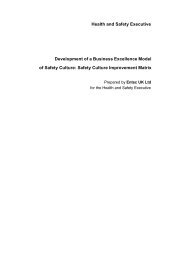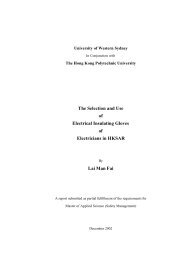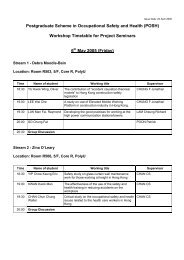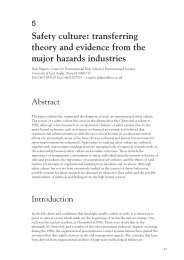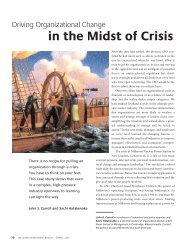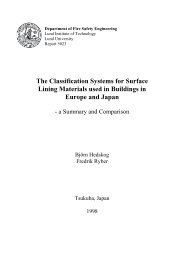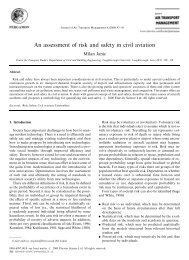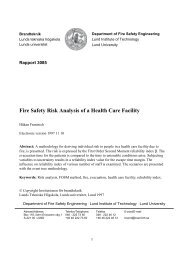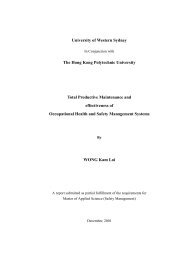Assessing safety culture in offshore environments - Industrial Centre
Assessing safety culture in offshore environments - Industrial Centre
Assessing safety culture in offshore environments - Industrial Centre
You also want an ePaper? Increase the reach of your titles
YUMPU automatically turns print PDFs into web optimized ePapers that Google loves.
112 S.J. Cox, A.J.T. Cheyne / Safety Science 34 (2000) 111±129In the wake of such changes, a Cross Industry Safety Leadership Forum has beenestablished to facilitate the shar<strong>in</strong>g of safe work<strong>in</strong>g practices. The members of thisforum recently highlighted a number of <strong>in</strong>dicators of improved <strong>safety</strong> performance(Cross Industry Safety Leadership Forum, 1997), <strong>in</strong>clud<strong>in</strong>g an overall decrease <strong>in</strong>reported <strong>in</strong>jury frequency rates and an estimated $5 billion <strong>in</strong> <strong>in</strong>vestments <strong>in</strong> healthand <strong>safety</strong>-related improvements. However, despite these overall e€orts, there issome evidence to suggest that the rate of improvement, as measured by accident/<strong>in</strong>jury frequency, has slowed down over the past 2 years (HSE, 1997; Cox andCheyne, 1999). Furthermore the Cross Industry Safety Leadership Forum (1997)have also con®rmed that much of the exist<strong>in</strong>g e€orts <strong>in</strong> support of these improvementshave been focused upon technology and management systems rather thanhuman factors. They also suggest that potential for future improvements may bestbe realised through enhanced e€orts <strong>in</strong> the areas of human factors and through theassociated developments <strong>in</strong> health and <strong>safety</strong> <strong>culture</strong>. In light of this <strong>in</strong>itiative thispaper considers how o€shore <strong>in</strong>stallation managers can gauge their <strong>safety</strong> <strong>culture</strong>.Discussion here focuses on the development of a generic <strong>safety</strong> <strong>culture</strong> assessmentmethodology which was designed to support improvements <strong>in</strong> <strong>safety</strong> performanceacross the sector.This paper describes a series of studies that are focused on the practical needs ofo€shore managers and workers for the monitor<strong>in</strong>g of <strong>safety</strong> <strong>culture</strong> through thedevelopment of a self-assessment tool. It aims to give a broad overview of thedevelopment of this methodology (Cox and Cheyne, 1999) and draws heavily uponrecent work carried out <strong>in</strong> the UK sector of the North Sea. It also explores thepractical utility of the concept <strong>in</strong> o€shore <strong>environments</strong>. The methods describedhere are concerned with both the development and pilot<strong>in</strong>g of this tool. Whereas themethodology is based on sound <strong>safety</strong> science, the overall aim of the assessmentprocess is to chart a path through, what is <strong>in</strong>creas<strong>in</strong>gly becom<strong>in</strong>g, a conceptualm<strong>in</strong>e®eld (Cox and Fl<strong>in</strong>, 1998), and one <strong>in</strong> which researchers have been challengedby <strong>in</strong>dustry to address practical issues (Cox and Lacey, 1998). Although much hasbeen done <strong>in</strong> other sectors (e.g. Hale and Hovden, 1998; Hofmann and Stetzer,1998) <strong>in</strong> these studies the cultural context for <strong>in</strong>vestigation is set with<strong>in</strong> the o€shore<strong>in</strong>dustry.1.1. Previous studiesA number of previous studies <strong>in</strong> o€shore <strong>environments</strong> have, either directly or<strong>in</strong>directly, considered employee perceptions and elements of health and <strong>safety</strong> <strong>culture</strong>.In an early study, Marek et al. (1985) exam<strong>in</strong>ed risk perceptions, stress andaccidents among di€erent work groups on an o€shore <strong>in</strong>stallation. They identi®edthe ma<strong>in</strong> <strong>in</strong>¯uences on <strong>safety</strong> as the implementation of a <strong>safety</strong> policy, `correct'<strong>safety</strong> management and <strong>safety</strong> promot<strong>in</strong>g activities, and <strong>in</strong>corporation of employees'views <strong>in</strong> design<strong>in</strong>g <strong>safety</strong> programmes. Similarly Rundmo (1993) implemented aquestionnaire survey of personnel on eight o€shore <strong>in</strong>stallations <strong>in</strong> the Norwegiansector of the North Sea; ®rstly to determ<strong>in</strong>e the personnel evaluations of riskresources and, secondly, to identify di€erences <strong>in</strong> risk perceptions among di€erent
S.J. Cox, A.J.T. Cheyne / Safety Science 34 (2000) 111±129 115data collection varies. Multiple and <strong>in</strong>dependent measures, if they provide supportiveevidence, can thus provide a more certa<strong>in</strong> picture (or pro®le) of the issue underreview (Denz<strong>in</strong>, 1978; Cox and Cheyne, 1999).In the same ve<strong>in</strong> James and Jones (1974) describe three di€erent approaches to theassessment of organisational <strong>culture</strong> (and climate) and, <strong>in</strong> do<strong>in</strong>g so, o€er commentaryon its di€erent (conceptual) loci. First, is the `multiple measurement-organisationalattribute approach' which regards organisational climate exclusively as a setof organisational attributes (or ma<strong>in</strong> e€ects), measurable by a variety of methods;e.g. organisational structure or organisational systems measured by propriety auditsystems. Second, there is the `perceptual-organisational attribute approach', whichviews organisational climate as a set of perceptual variables which are still seen asorganisational e€ects, e.g. views of the organisation's commitment, etc. F<strong>in</strong>ally,there is the `perceptual measurement-<strong>in</strong>dividual attribute approach' which capturesorganisational climate through perceptions of <strong>in</strong>dividual attributes, e.g. <strong>in</strong>dividuals'feel<strong>in</strong>gs and attitudes towards organisational issues, their related behaviour, etc.Given the importance of both organisational and <strong>in</strong>dividual factors <strong>in</strong> <strong>in</strong>¯uenc<strong>in</strong>g<strong>safety</strong> <strong>culture</strong> (James and Jones, 1974; Denison, 1996) it is suggested that <strong>in</strong> anattempt to measure <strong>culture</strong> these di€erent approaches should be treated as complementaryand not as alternatives. Thus a multiple perspective was taken whichalso comb<strong>in</strong>ed di€erent approaches to assessment, as recommended by Jick (1979).This is illustrated <strong>in</strong> the framework model shown <strong>in</strong> Fig. 1.In such a model, the representation of organisational <strong>safety</strong> <strong>culture</strong> is consistentwith one sponsor's preferred (HSE, 1997) de®nition. For example, the AdvisoryFig. 1. Multiple perspective model of <strong>safety</strong> <strong>culture</strong> assessment.
employed here for two reasons: (1) to elicit constructs based on <strong>in</strong>dividuals' notionsof `<strong>safety</strong> <strong>culture</strong>'; and (2) to provide <strong>in</strong>itial <strong>in</strong>dications of any di€erences <strong>in</strong> overallperceptions between di€erent work groups <strong>in</strong> the study organisations. The focusgroup studies were deemed to be particularly appropriate at this stage of the <strong>in</strong>vestigationss<strong>in</strong>ce the data collected would be utilised as the basis for the toolkit developmentand, <strong>in</strong> particular, the development of the questionnaire tool. Focus groupsas a method are well accepted (Krueger, 1994) but they can be biased by a numberof factors, e.g. dom<strong>in</strong>ation of the group by one member or too much direction bythe facilitator. These biases were controlled for by the use of a small number ofgroup facilitators who followed a structured discussion format.2.1. MethodA series of focus group discussions (n=40) were conducted us<strong>in</strong>g both o€shoreand onshore personnel <strong>in</strong> three separate organisations, at a total of six di€erentlocations. These 40 discussion groups <strong>in</strong>volved 375 employees <strong>in</strong> groups rang<strong>in</strong>gbetween three and 12 <strong>in</strong>dividuals. One hundred and eighty-one participants worked<strong>in</strong> onshore locations and 194 were based on o€shore <strong>in</strong>stallations. Eighty-threemanagers and supervisors took part <strong>in</strong> the study. Wherever possible the groups werehomogenous and comprised either: (1) managers and supervisors; or (2) members ofthe workforce. This promoted an atmosphere of open enquiry and, wherever possible,avoided <strong>in</strong>hibit<strong>in</strong>g the group members (Carroll, 1998).Each of the discussions <strong>in</strong>volved four questions be<strong>in</strong>g put to the group participants,namely what they understood by the term <strong>safety</strong>, what they understood bythe term company <strong>culture</strong>, how <strong>safety</strong> ®ts <strong>in</strong>to their picture of company <strong>culture</strong> andwhat they understood by the term <strong>safety</strong> <strong>culture</strong>. The ®rst three questions weredesigned to put participants at their ease and help focus their discussion of theconcept of <strong>safety</strong> <strong>culture</strong>. All members of the group were encouraged by the facilitatorto make a response to the ®nal question.Each of the focus group discussions were recorded on audiotape and then transcribedverbatim. These transcriptions were then subjected to a prelim<strong>in</strong>ary contentanalysis (Holsti, 1969; Dane, 1990) <strong>in</strong>volv<strong>in</strong>g two <strong>in</strong>dependent raters, and theresult<strong>in</strong>g keywords (based on the most commonly occurr<strong>in</strong>g constructs <strong>in</strong> the discussionsof the concept of <strong>safety</strong> <strong>culture</strong>) were tabulated. There was 96% agreementbetween raters on the classi®cation of concepts. Where the raters did not agree onthe categorisation of a concept (<strong>in</strong> 13 cases), a third rater arbitrated. In addition tothe extraction of <strong>in</strong>dividual key constructs, general group feel<strong>in</strong>gs and perceptions of<strong>safety</strong> were recorded as appropriate.2.2. ResultsS.J. Cox, A.J.T. Cheyne / Safety Science 34 (2000) 111±129 117All groups actively participated with a good degree of co-operation. The numberof occasions each concept was mentioned dur<strong>in</strong>g the focus discussion groups isshown <strong>in</strong> Table 1, together with a breakdown by organisation. The numbers shown<strong>in</strong> brackets <strong>in</strong>dicate the number of times each issue was raised <strong>in</strong> a negative sense.
118 S.J. Cox, A.J.T. Cheyne / Safety Science 34 (2000) 111±129Table 1Focus group keywordsKeyword Organisation 1 Organisation 2 Organisation 3 TotalInvolvement <strong>in</strong> <strong>safety</strong> issues 6(3) 67(20) ± 73Physical work environment 2(2) 52(34) 2(1) 56Priority of <strong>safety</strong> over other issues 11(10) 44(37) ± 55Management actions for <strong>safety</strong> 3(2) 20(15) 27(21) 50Management commitment 9(3) 21(6) 7(2) 37Apportion<strong>in</strong>g of blame 5(4) 29(20) ± 34Safe systems/procedures ± ± 23(17) 23Accidents ± ± 11(10) 11Attitudes to personal <strong>safety</strong> ± ± 10(2) 10Safety tra<strong>in</strong><strong>in</strong>g and <strong>in</strong>struction 2(1) 5(1) ± 7Safety legislation ± ± 6(4) 6Total number of discussion groups 7 19 15 40For example, <strong>in</strong> the case of <strong>in</strong>volvement, the number of time <strong>in</strong>dividuals felt thatthey were not <strong>in</strong>volved <strong>in</strong> <strong>safety</strong> issues.Many of the non-managerial participants, especially with<strong>in</strong> Organisation 2,recounted experiences of not feel<strong>in</strong>g that they were add<strong>in</strong>g value to <strong>safety</strong>-relatedprocesses and perceived that they were not <strong>in</strong>volved <strong>in</strong> any <strong>safety</strong> decision-mak<strong>in</strong>gprocesses a€ect<strong>in</strong>g anyth<strong>in</strong>g other than rout<strong>in</strong>e day-to-day operations. Responsesfrom o€shore workers suggest that they have a greater appreciation of risk thanonshore workers which, <strong>in</strong> turn, a€ects their perception of <strong>safety</strong> issues and may gosome way to expla<strong>in</strong><strong>in</strong>g the many emotive comments made about the importance of<strong>safety</strong> o€shore. The responses from the onshore groups represented a more sanitisedviewpo<strong>in</strong>t, given with much less emotion than those received from the o€shoregroups. Several groups expressed the view that, although attitudes to <strong>safety</strong> hadimproved, they perceived that the pr<strong>in</strong>ciples of risk management were provid<strong>in</strong>g thema<strong>in</strong> impetus for improvements <strong>in</strong> all three organisations. Comb<strong>in</strong>ed responsessuggest that management were quite committed to <strong>safety</strong> although improvementscould still be made. Although some non-managerial participants, particularly <strong>in</strong>o€shore <strong>environments</strong>, related feel<strong>in</strong>gs that a blame <strong>culture</strong> existed.2.3. DiscussionOf the constructs identi®ed, management commitment, management actions for<strong>safety</strong> and the physical work environment were the more common across all threeorganisations, although <strong>in</strong>volvement <strong>in</strong> <strong>safety</strong> issues and the priority given to <strong>safety</strong>issues were also highlighted as important. These results give some <strong>in</strong>dication of how<strong>safety</strong> <strong>culture</strong> is perceived by those work<strong>in</strong>g <strong>in</strong> the o€shore environment and areconsistent with earlier ®nd<strong>in</strong>gs both on and o€shore (Zohar, 1980; Fl<strong>in</strong> et al., 1996).The constructs uncovered provided the basis, together with the review of currentliterature on <strong>safety</strong> <strong>culture</strong> assessment (Cox and Fl<strong>in</strong>, 1998) and climate identi®cation,for the construction of a set of climate assessment tools. It should be noted
120 S.J. Cox, A.J.T. Cheyne / Safety Science 34 (2000) 111±129<strong>safety</strong> attitude measures have also been developed and utilised <strong>in</strong> other <strong>in</strong>dustrialsectors (e.g. Zohar, 1980; Brown and Holmes, 1986; Cox, 1988; Dedobbeleer andBe land, 1991; Cooper and Philips, 1994; Mearns et al., 1998). An <strong>in</strong>itial questionbank, derived from the <strong>in</strong>itial <strong>in</strong>-house studies, was re®ned <strong>in</strong> the light of otherpublished studies. Consideration was given to developments with<strong>in</strong>: (1) the nuclear<strong>in</strong>dustry (Lee, 1995); (2) the energy supply <strong>in</strong>dustry (see Donald, 1995, for details);(3) a variety of manufactur<strong>in</strong>g sett<strong>in</strong>gs (Cox and Cox, 1991; Cheyne and Cox, 1994;Cox et al., 1998); and (4) the HSE attitud<strong>in</strong>al <strong>in</strong>dicator of <strong>safety</strong> climate (Byrom andCorbridge, 1997). Extra dimensions, not <strong>in</strong>cluded <strong>in</strong> the common threads from previousstudies <strong>in</strong> participat<strong>in</strong>g organisations, were <strong>in</strong>cluded if common to two ormore of the external studies and if highlighted by the focus group discussions (Study1). The full set of dimensions and their orig<strong>in</strong> is shown <strong>in</strong> Table 2.In summary, the <strong>in</strong>itial question bank for the questionnaire <strong>in</strong>strument was,therefore, based on:1. an <strong>in</strong>itial review of o€shore surveys with<strong>in</strong> the study organisations and theestablishment of common themes;2. comparisons between these and <strong>in</strong>struments <strong>in</strong> other <strong>in</strong>dustrial sectors (<strong>in</strong> particularthe nuclear and chemical/process <strong>in</strong>dustries); and3. a review of the constructs identi®ed <strong>in</strong> the focus discussion groups (Study 1 above).These reviews and comparisons allowed a pilot questionnaire to be developed to<strong>in</strong>clude 47 items cover<strong>in</strong>g the areas of Management Commitment, Communication,Priority of Safety, Safety Rules and Procedures, Supportive Environment, Involvement,Personal Priorities and Need for Safety, Personal Appreciation of Risk andWork Environment. This attitude questionnaire was piloted us<strong>in</strong>g a population ofo€shore personnel <strong>in</strong> two locations. These personnel were asked not only to completethe questionnaire but also to comment on the general content and any speci®citems they felt to be unclear. Sixty completed questionnaires were returned. Thema<strong>in</strong> objective of this pilot study was to test the face validity of the items <strong>in</strong> thequestionnaire with an appropriate group. Comments were restricted to <strong>in</strong>dividualitems and resulted <strong>in</strong> two items be<strong>in</strong>g reworded and four items be<strong>in</strong>g deleted. Thenew, 43-item questionnaire was tested on a larger pilot population.3.2. AnalysisThe questionnaire was distributed to 350 employees on three o€shore <strong>in</strong>stallations.Two-hundred and twenty-one questionnaires were returned, represent<strong>in</strong>g a63% response rate. There was no evidence that this sample was unrepresentative ofthe total population. These data were subjected to a series of statistical tests <strong>in</strong>clud<strong>in</strong>gcon®rmatory factor analysis (CFA), <strong>in</strong>ternal-scale consistency and alternateforms reliability tests.3.2.1. Factor analysisThe data were subjected to CFA us<strong>in</strong>g version 5.1 of the EQS (structural equation)program (Bentler and Wu, 1995). In CFA the researcher postulates a model (a
S.J. Cox, A.J.T. Cheyne / Safety Science 34 (2000) 111±129 123Table 5Alternate-forms reliability coecientsItemInter-item correlationManagement acts decisively when a <strong>safety</strong> concern is raised 0.622*Managers and supervisors express concern if <strong>safety</strong> procedures are not adhered to 0.353*Management considers <strong>safety</strong> to be equally as important as production 0.583*There is good communication here about <strong>safety</strong> issues which a€ect me 0.036Safety <strong>in</strong>formation is always brought to my attention by my l<strong>in</strong>e0.089manager/supervisorSome health and <strong>safety</strong> rules and procedures are not really practical 0.589*Employees are not encouraged to raise <strong>safety</strong> concerns 0.561*When people ignore <strong>safety</strong> procedures here, I feel it is none of my bus<strong>in</strong>ess 0.361*I can <strong>in</strong>¯uence health and <strong>safety</strong> performance here 0.555*I am never <strong>in</strong>volved <strong>in</strong> the ongo<strong>in</strong>g review of <strong>safety</strong> 0.292Safety is the number one priority <strong>in</strong> my m<strong>in</strong>d when complet<strong>in</strong>g a job 0.564*I understand the <strong>safety</strong> rules for my job 1*It is important that there is a cont<strong>in</strong>u<strong>in</strong>g emphasis on <strong>safety</strong> 1*I am rarely worried about be<strong>in</strong>g <strong>in</strong>jured on the job 0.664*I cannot always get the equipment I need to do the job safely 0.361*Operational targets often con¯ict with <strong>safety</strong> measures 0.363*Sometimes I am not given enough time to get the job done safely 0.728**Signi®cance at the 0.05 level.the factors <strong>in</strong> Table 3 are presented <strong>in</strong> Table 4. It can be seen that all the alphasreported are <strong>in</strong> the range 0.53 through 0.84, the lower ones be<strong>in</strong>g consistent withthose factors where some orig<strong>in</strong>al factor load<strong>in</strong>gs were low.Alternate-forms reliability <strong>in</strong>volves compar<strong>in</strong>g two di€erent versions of the samemeasure (Dane, 1990). In the case of the questionnaire, 30 subjects were asked tocomplete the survey and then later, after an <strong>in</strong>terval of at least 18 h, were asked 17 ofthose items orally as part of an <strong>in</strong>terview format. These items were chosen randomlyfrom the larger questionnaire. The <strong>in</strong>ter-item correlations are shown <strong>in</strong> Table 5.Only three of the <strong>in</strong>ter-item correlations are non-signi®cant, <strong>in</strong>dicat<strong>in</strong>g overall goodalternate-forms reliability. The low <strong>in</strong>ter-item correlation <strong>in</strong> these cases may havebeen due to the relatively small sample size <strong>in</strong>volved and the e€ect of a few outly<strong>in</strong>gscores on such a sample.3.3. DiscussionThis study has dealt with one of the tools for use <strong>in</strong> a <strong>safety</strong> climate assessment, aswell as detail<strong>in</strong>g its development, the <strong>in</strong>strument's reliability and consistency hasalso been discussed. This tool has been based, wherever possible on the conceptshighlighted by the focus group discussions (Study 1) and a review of relevant literatureperta<strong>in</strong><strong>in</strong>g to the measurement and assessment of <strong>safety</strong> <strong>culture</strong> and climate.The organisations <strong>in</strong>volved also requested that any questionnaire tool developed beconsistent with what had been used <strong>in</strong> the past. The ®nal section of this paper brie¯ydescribes the use of the toolkit and discusses some of the issues raised, the pro®l<strong>in</strong>g
124 S.J. Cox, A.J.T. Cheyne / Safety Science 34 (2000) 111±129of the results of the assessment process, and subsequent actions that may be consideredby those assess<strong>in</strong>g <strong>safety</strong> climate. The con®dential nature of the assessmentprocess makes it dicult to report this study <strong>in</strong> great detail.4. Illustration of the toolkit <strong>in</strong> practiceThe developed ``Safety Climate Assessment Toolkit'' process was <strong>in</strong>itially tested<strong>in</strong> one organisation <strong>in</strong>volved <strong>in</strong> hydrocarbon production. The pilot organisation is<strong>in</strong>volved <strong>in</strong> the extraction of hydrocarbons, operat<strong>in</strong>g on various sites world-wide.This organisation had a strong commitment to <strong>safety</strong>, health and environmentalexcellence and also has a tradition of `quality'. The <strong>in</strong>itial management characterisationof their <strong>culture</strong> for <strong>safety</strong> was one of `total commitment and <strong>safety</strong> excellence'.The organisation hoped to appreciate a broader perspective of sharedattitudes and communicate these goals through the use of the assessment toolkit, aswell as exam<strong>in</strong><strong>in</strong>g di€erences between occupational groups. The toolkit procedureswere implemented by an <strong>in</strong>-house team, who only made use of back-up from theresearch team <strong>in</strong> analys<strong>in</strong>g the di€erences between occupational groups.The full assessment toolkit (Cox and Cheyne, 1999) consists of three sets of tools,as described earlier: climate questionnaire, semi-structured <strong>in</strong>terview schedule and aset of behavioural <strong>in</strong>dicators. It also provides guidance on their application and<strong>in</strong>terpretation. The organisation us<strong>in</strong>g the toolkit <strong>in</strong> this case considered the follow<strong>in</strong>gsources of evidence:Fig. 2. Radar plot for pilot organisation.
S.J. Cox, A.J.T. Cheyne / Safety Science 34 (2000) 111±129 125Table 6Means for the three work groups <strong>in</strong>volved <strong>in</strong> the study aDependent variable Managers Production Drill<strong>in</strong>gCommunication 6.4 6.24 5.56Supportive environment 6.64 6.02 5.92Involvement 5.75 4.75 4.45Personal priorities 9.2 8.86 7.89Personal appreciation of risk 8.75 7.75 7.71Work environment 9.1 7.95 6.62a Emboldened groups di€er signi®cantly from the others (Tukey tests, P
126 S.J. Cox, A.J.T. Cheyne / Safety Science 34 (2000) 111±129ences between managers, production teams and drill<strong>in</strong>g teams. A series of one-wayanalyses of variance were performed for each factor <strong>in</strong> the attitude questionnaire.Di€erences <strong>in</strong> mean scores (standardised to a 10-po<strong>in</strong>t scale for each factor) for eachof the three groups are shown <strong>in</strong> Table 6.Di€erences were found <strong>in</strong> six of the questionnaire dimensions with drill<strong>in</strong>g teamsshow<strong>in</strong>g signi®cantly lower evaluations than managers <strong>in</strong> terms of Supportiveenvironment, Involvement, Personal appreciation of risk and Work environmentand lower evaluations of Communication and Personal priorities than both managersand production teams. Production teams, however, only di€ered signi®cantlyfrom managers <strong>in</strong> terms of Involvement, Personal appreciation of risk and workenvironment. These ®nd<strong>in</strong>g are consistent with those of Mearns et al. (1998) suggest<strong>in</strong>gthat drill<strong>in</strong>g teams, who often belong to another `parent organisation' mayhave their own sub-<strong>culture</strong> and may, consequently, ®nd themselves outside variouscommunication channels.4.2. DiscussionUsers found the process straightforward and found little diculty <strong>in</strong> construct<strong>in</strong>gtheir <strong>safety</strong> climate pro®le. Users then exam<strong>in</strong>ed the <strong>in</strong>itial questionnaire items and<strong>in</strong>terview responses <strong>in</strong> order to get some notion of the exact nature of any problemshighlighted by poor scores. This <strong>in</strong>vestigation revealed that a large number ofemployees felt that they were not <strong>in</strong>volved, <strong>in</strong>, or <strong>in</strong>formed of, <strong>safety</strong> <strong>in</strong>itiatives,<strong>in</strong>deed it was perceived that a small group of `select' people were the only <strong>in</strong>dividuals<strong>in</strong>volved <strong>in</strong> any <strong>safety</strong> activities, and these <strong>in</strong>dividuals gave little, or no, support toothers on <strong>safety</strong> issues. These feel<strong>in</strong>gs were also re¯ected with regard to <strong>safety</strong>tra<strong>in</strong><strong>in</strong>g. Once aga<strong>in</strong>, the majority of those questioned felt that they were not<strong>in</strong>formed of relevant tra<strong>in</strong><strong>in</strong>g or encouraged to attend courses, other than thoselegally required.Several <strong>in</strong>itiatives are planned as a result of these ®nd<strong>in</strong>gs. Firstly, the users havedecided to actively promote, with the help of the tra<strong>in</strong><strong>in</strong>g manager, the range of<strong>safety</strong> tra<strong>in</strong><strong>in</strong>g courses on o€er. This <strong>in</strong>volves list<strong>in</strong>gs of appropriate coursesappear<strong>in</strong>g <strong>in</strong> the company newsletter, as well as announcements at all team meet<strong>in</strong>gs<strong>in</strong> an attempt to reach the various `sub-<strong>culture</strong>s'. Team meet<strong>in</strong>gs are also to be used,<strong>in</strong> the ®rst <strong>in</strong>stance, to encourage <strong>in</strong>dividuals to get <strong>in</strong>volved <strong>in</strong>, and <strong>in</strong>deed to propose,new <strong>safety</strong> <strong>in</strong>itiatives. The user will reassess the <strong>safety</strong> climate pro®le whenthese measures have been <strong>in</strong> place for at least 1 year.5. DiscussionThis paper has described the development of an <strong>in</strong>novative approach to assess<strong>in</strong>g<strong>culture</strong>, and speci®cally <strong>safety</strong> <strong>culture</strong> and climate. The development of the ``SafetyClimate Assessment Toolkit'' has exploited the notions of multiple organisationalperspectives and data triangulation (Jick, 1979). It utilises approaches which can becomb<strong>in</strong>ed to provide an <strong>in</strong>-depth picture of an organisation's current <strong>safety</strong> climate.
S.J. Cox, A.J.T. Cheyne / Safety Science 34 (2000) 111±129 129Fitzpatrick, D., 1996. Employee Attitudes O€shore. Unpublished M.Sc. dissertation, LoughboroughUniversity, UK.Fl<strong>in</strong>, R.H., Mearns, K.J., 1994. Risk Perception and Safety <strong>in</strong> the O€shore Oil Industry. Second InternationalConference on Health, Safety, and the Environment <strong>in</strong> Oil and Gas Exploration, Jakarta.Fl<strong>in</strong>, R., Mearns, K., Flem<strong>in</strong>g, M., Gordon, R., 1996. Risk Perception and Safety <strong>in</strong> the O€shore Oil andGas Industry, (O€shore Technology Report OTH 94 454). HSE Books, Sudbury.Hale, A.R., Hovden, J., 1998. Management and <strong>culture</strong>: the third age for <strong>safety</strong>. A review of approachesto organizational aspects of health, <strong>safety</strong> and environment. In: Feyer, A.-M., Williamson, A. (Eds.),Occupational Injury: Risk, Prevention and Intervention. Taylor and Francis, London, pp. 129±165.Hofmann, D.A., Stetzer, A., 1998. The role of <strong>safety</strong> climate and communication <strong>in</strong> accident <strong>in</strong>terpretation:implications for learn<strong>in</strong>g from negative events. Academy of Management Journal 41, 644±657.Holsti, O.R., 1969. Content Analysis for the Social Sciences and Humanities. Addison-Wesley, Read<strong>in</strong>g,MA.HSE, 1997. Health and Safety Climate Tool Process Guidel<strong>in</strong>es. Health and Safety Exectutive Books,Sudbury.James, L.R., Jones, A.P., 1974. Organisational climate: a review of theory and research. PsychologicalBullet<strong>in</strong> 81 (12), 1096±1112.Jick, T.D., 1979. Mix<strong>in</strong>g qualitative and quantitative methods: triangulation <strong>in</strong> action. Adm<strong>in</strong>istrativeScience Quarterly 24, 602±611.Krueger, R.A., 1994. Focus Groups, 2nd Edition. Sage, Thousand Oaks.Lee, T.R., 1995. The role of attitudes <strong>in</strong> the <strong>safety</strong> <strong>culture</strong> and how to change them. Conference on`Understand<strong>in</strong>g Risk Perception', O€shore Management <strong>Centre</strong>, Robert Gordon University, 2 February,Aberdeen.Litw<strong>in</strong>, M.S., 1995. How to Measure Survey Reliability and Validity. Sage, Thousand Oaks.Marek, J., Tangenes, B., Hellesouy, O., 1985. Experience of Risk and Safety. Work Environment StatfjordField. Oslo University.Marsh, H.W., Balla, J.R., Hau, K., 1996. An evaluation of <strong>in</strong>cremental ®t <strong>in</strong>dices: a clari®cation ofmathematical and empirical properties. In: Marcoulides, G.A., Schumacker, R.E. (Eds.), AdvancedStructural Equation Model<strong>in</strong>g: Issues and Techniques. LEA, Mahwah, NJ, pp. 315±354.Mearns, K., Fl<strong>in</strong>, R., Gordon, R., Flemm<strong>in</strong>g, M., 1998. Measur<strong>in</strong>g <strong>safety</strong> climate on o€shore <strong>in</strong>stallations.Work and Stress 12, 238±254.Rundmo, T., 1993. Risk perception and occupational accidents on o€shore petroleum platforms. Paperpresented at the 2nd O€shore Installation Management Conference, The Robert Gordon University,Aberdeen, April.Sche<strong>in</strong>, E.H., 1985. Organisational Culture and Leadership. Jossey-Bass, San Francisco, CA.Zohar, D., 1980. Safety climate <strong>in</strong> <strong>in</strong>dustrial organisations: theoretical and applied implications. Journalof Applied Psychology 65 (1), 96±102.


